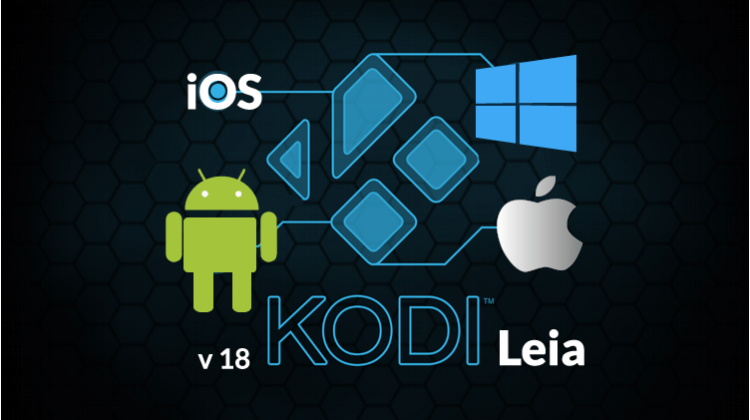
After a while in the version Beta, Kodi 18 Leia was finally released for the joy of its users. In this article we’ll talk about the new features, change log and Install Guides covering all the operative systems. So whatever be the OS of your device, you’ll find it here…
Kodi 18.0 Leia is finally out and available for download on Amazon devices, Android, iOS, Windows PC, Mac, Linux, and Raspberry Pi. The new Kodi version had been in development for the last two years, and with the major code refactoring and changes to its Graphical User Interface (GUI), Kodi 18 Leia is expected to greatly enhance the experience we’ve so far gotten from its predecessor Kodi 17.6 Krypton.
As you would expect, there are numerous changes that have been made to improve our streaming and the general Kodi experience.
First Things First: Use Kodi Safely
ISP and government snooping is on the rise, and many Kodi users have been caught on the wrong side of the law. Though Kodi itself is legal, most of the third-parties addons that are used for streaming movies, TV shows, sports, live TV, etc are illegal. This is because they provide access to copyrighted content. Many users have therefore ended up getting DMCA notices, and others even facing charges.
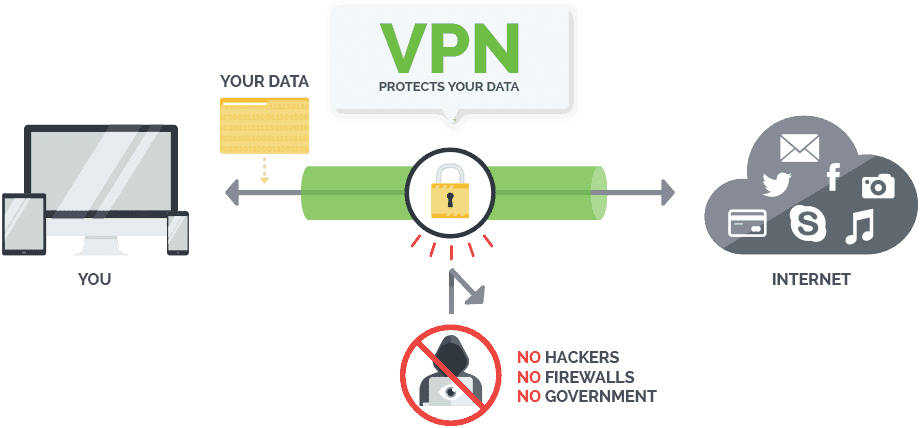
What’s New?
Here’s a list of the new additions on Kodi
- Retroplayer gaming and associated game control support
- Digital Rights Management decryption support
- Music Library – new ways to explore and enjoy your music
- Live TV improvements, including support for new back-ends
- Binary addon support and the binary addon repository
- Android Leanback and voice control
- Playback improvements (audio and video), including improved Blu-ray support
- Estuary skin modifications and changes to the GUI/skinning engine
- Revised codebase and build guides
- Platform specifics
Other new additions that are not on the forefront include Bluetooth support, CMake build system, visualisations and screensavers, improvements to the JSON-RPC API, improved code stability, performance and security (as well as general code clean-up in many core areas), remote control changes, web interface changes, logging changes, dependency changes, and many more.
Kodi 18 Leia Upgrade tips
Before you upgrade your Kodi version to Kodi 18, you need to take a few steps to ensure that you don’t lose your data.
- Switch back your Kodi theme to the default Estuary skin before updating.
This is because your Kodi may face some compatibility issues during the upgrade, and you will most likely not have everything as smooth as it should be. When you upgrade, you’ll also be able to use the following skins which have been upgraded for Kodi 18.
- Transparency
- Confluence
- Rapier
- Pellucid
After that, you can go ahead and start the upgrade process. You’ll find the steps below for most platforms.
If you want to back up your Kodi before updating, you can check out our Kodi back up guide.
Kodi 18 Leia Download and Install Guide
If you had installed Kodi Krypton 17.6, your device should be able to support Kodi 18 Leia.
Amazon FireStick (and Fire TV devices)
Kodi 18 can be installed on all Amazon streaming devices.
Here’s a complete guide on how to install Kodi 18 Leia on Firestick
The same procedure can be followed if you are upgrading from Kodi Krypton
Download Kodi 18 Leia for Windows

Download Kodi 18 Leia for Mac
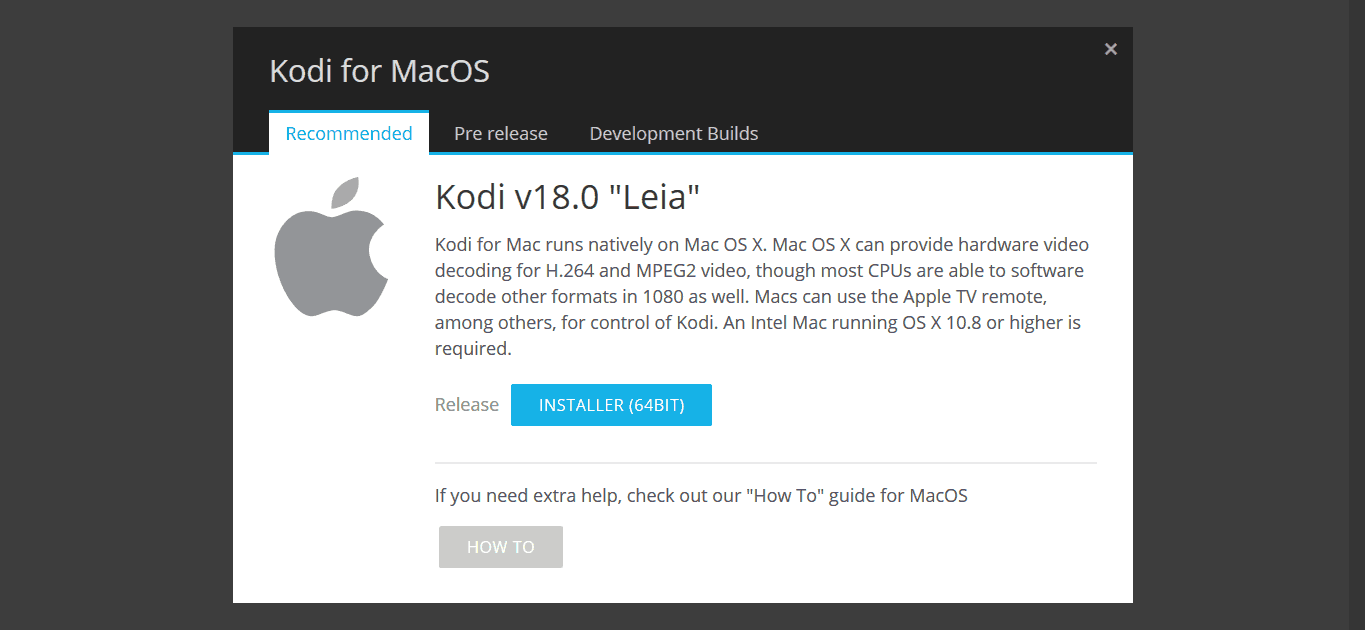
Here’s a more detailed guide on how to install Kodi 18 Leia on Mac.
Kodi 18 Leia for iOS
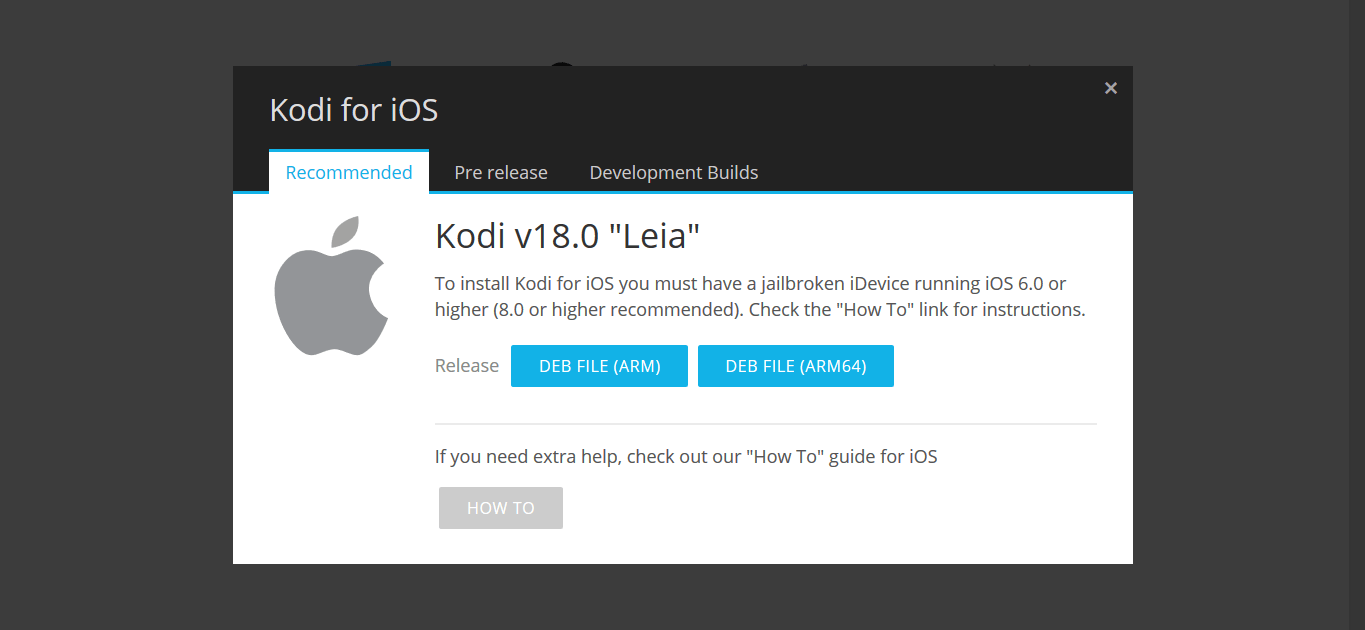
Download Kodi 18 Leia APK for Android
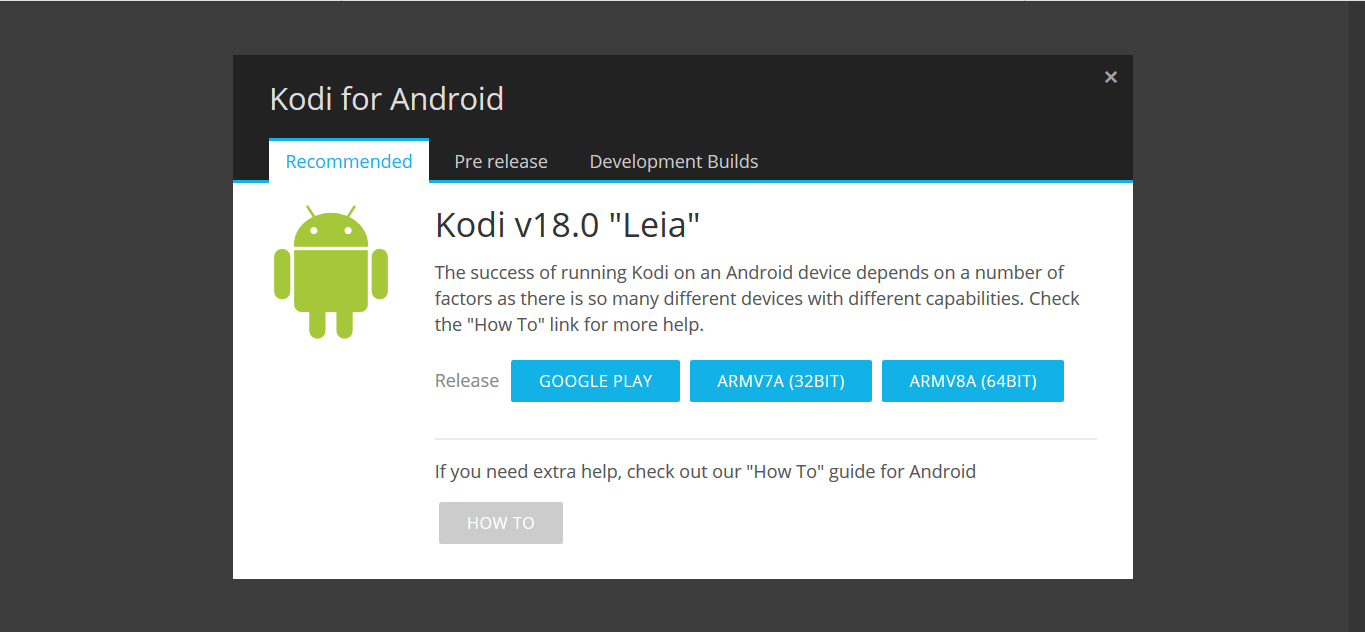
Get Kodi 18 Leia on Xbox One
You can easily install Kodi 18 Leia for Xbox One from the official Microsoft store. Here are the steps.
- Power up your Xbox One
- Click the Search option on the home screen
- Type in Kodi
- Click the Kodi icon in the search results
- Click Get on the next screen
- Wait for the installation to complete
How to install Kodi 18 Leia on Linux
To install Kodi 18 Leia on Linux, you need to enter a bunch of codes in the terminal.
Here are the codes
sudo apt-get install software-properties-common
sudo add-apt-repository ppa:team-xbmc/ppa
sudo apt-get update
sudo apt-get install kodi
Check out this guide for more detailed instructions.
Kodi 18 Leia for Raspberry Pi
Here is the detailed installation guide on how to install Kodi on Raspberry Pi
Generic Installation Steps for Kodi Leia
Below is the generic installation steps for the various devices that support Kodi.
- Go to https://kodi.tv/download
- Under “Choose your Weapon,” select your Operating System
- Click the appropriate link to download the app file for your device
- Install it just like any other app.
After installing Kodi 18 Leia, check out our detailed Kodi addon guides that we’ve made to help you get the best out of your Kodi.
Kodi 18 Leia: Complete Changelog
This is intended to be as a most complete changelog for Kodi 18 Leia, regarding the previous version 17.6.
1.1 Gaming (Games interface and Game Clients)
- Added a “Games” window to GUI (games are managed using a basic file browser as a game library does not exist yet)
- Added a RetroPlayer player core supporting game clients addons as well as emulator cores via libretro API
- Added extentions to Kodi’s Addons AP to support Game Client Addons, supporting Kodi’s VFS (Virtual File System), etc.
- Added support for Game Client Addons as new type of addons with just-in-time emulator installation
- Added a Games window and Game OSD (On-Screen-Display) entries to the GUI
- Added a gaming and game configuration interface for Game settings to the GUI
- Added support for Game Info Tags (game info tag) and exposed properties to Python list items
- Added a savestate (savestate) manager to Kodi for games
- Added initial support for basic gameplay persistence (auto-save & auto-load)
- Added support for in-game (save RAM) saves
- Added support for Keyboard players via Joystick Emulation
- Added Game API acbstraction for game controller multitaps (a.k.a. hubs) including topology GUI display
- Added Game API acbstraction to support gamepad/joystick remapping for games (per game-addon)
- Added Game API acbstraction to support keyboard remapping for games (per game-addon)
- Added Game API acbstraction to support mouse remapping for games (per game-addon)
- Added support for libretro API and game cores (emulators and games) that support it as binary addons
- Added game clients addons for many popular third-party game console emulators and native open source games *
- * Game clients addons for Kodi is changing quickly so checkout the game clients addons article for a current list
1.2 Live TV and PVR (Personal Video Recorder)
- Added support for RDS (Radio Data System) for radio channels if the PVR backend client support RDS
- Added new settings for ‘Startup action’ and add ‘Play TV/Radio
- Added support for global direct channel number input & global unique channel numbers
- Added support for no delay on switch to previous channel with key 0 when using direct channel number input
- Added context menu support for Estuary (skin) PVR home screen widgets
- Added percent played progress bar to PVR info panel (for recordings) in Estuary (skin)
- Added Info support to recently played channel widget to Estuary (skin) home screen
- Added episode name to Live TV, recordings OSD sub label, and cleanup seekbar for Live TV in Estuary (skin)
- Added Season/Episode info in Guide window and dialog in Estuary (skin)
- Added support for next and previous buttons in OSD Timeshift window
- Added feature to prefill recordings folder with timer title in the timer settings dialog
- Added support for radio channel groups to the channelgroup manager
- Added support for a ‘Smart selection’ of EPG events feature to the guide window
- Added ‘Go to date’ context menu item to the guide window
- Added support for channel groups selector to the guide window
- Added possibility to switch between horizontal and vertical epg grid view to the guide window
- Added support to sort content by channel number/channel name/last played, support sort order to the Guide window
- Added support next/previous chapter in PVR recordings
- Improved PVR seekbar and info dialog in Estuary (skin)
- Improved PVR info panel, info dialog, and recordings window in Estuary (skin)
- Improved support for enabling multiple PVR client addons
- Improved support for for subchannel numbers support (ATSC)
- Improved OSD Timeshift GUI
- Improved the guide window for better consistency and readability
- Changed GUI actions to eliminate duplicate and dead code (major GUI refactoring for PVR and LiveTV)
- Changed implementation of EPG search filter (EPG search dialog) completely
- Changed Guide Window removing obsolete views “channel”, “now” and “next”
- Changed “play minimized” settings handling
- Changed ‘epg.lingertime’ to an official setting, remove the respective advanced setting
- Changed shared channel selection into an optional setting
- Removed obsolete and unused setting ‘pvrplayback.scantime’
- Removed channel guide button from EPG event info dialog, add ‘channel guide’ to context menu
- Removed setting ‘hide connection lost warning’
- Removed non-working recording settings defaults
- Recordings window: Content view filter
- PVR-Addon API changes
- Added, updated, and improved PVR backend clients addons for popular third-party external PVR backend platforms:
- New: Zattoo PVR Client PVR Addon backend client maintained and available from Kodi’s community
- New: Teleboy PVR Client PVR Addon backend client maintained and available from Kodi’s community
- New: Sledovanitv.cz PVR Client PVR Addon backend client maintained and available from Kodi’s community
- PVR Demo Client dummy addon with fake (method stub) PVR backend for PVR skinning and regression testing
- IPTV Simple Client PVR Addon backend client maintained and available from Kodi’s community
- FilmOn PVR Addon backend client maintained and available from Kodi’s community
- Stalker Middleware PVR Addon backend client maintained and available from Kodi’s community
- HDHomeRun PVR Addon backend client maintained and available from Kodi’s community
- Digital Devices Octopus NET Client PVR Addon backend client maintained and made available by Digital Devices
- Enigma2 (Dreambox / Vu+ / DBox2) PVR Addon backend client maintained and available from Kodi’s community
- VBox TV Gateway PVR Addon backend client maintained and available from Kodi’s community
- Njoy Digital (N7) PVR Addon backend client maintained and available from Kodi’s community
- PCTV Systems (Broadway) PVR Addon backend client maintained and available from Kodi’s community
- Tvheadend HTSP Client PVR Addon backend client maintained and available from Kodi’s community
- VDR VNSI Client PVR Addon backend client maintained and available from Kodi’s community
- MythTV PVR Client Addon backend client maintained and available from the Kodi’s community
- NextPVR (former GB-PVR) PVR Addon backend client maintained and available from Kodi’s community
- Argus TV (former ForTheRecord) PVR Addon backend client maintained and available from Kodi’s community
- DVBLink PVR Client Addon backend client maintained and available from Kodi’s community
- DVBViewer Client PVR Addon backend client maintained and available from Kodi’s community
- MediaPortal PVR Client Addon backend client maintained and available from Kodi’s community
- WMC (Windows Media Center) PVR Addon backend client maintained and available from Kodi’s community
1.3 Add-ons Framework, API, and Manager
- Implemented a Python 3 interpreter inside Kodi (plus enforcing Python 2 & 3 compatibility in Leia addon repository)
- Implemented online binary addon repository from which Kodi can now automatically installs/updates binary addon
- Major refactoring of Kodi’s core handling and GUI management of binary addons
- Added framework to support VFS (Virtual File System) as binary addons
- Added framework support for binary addons for video decoder codecs
- Added framework support for binary addons for image (picture) decoder codecs
- Added extentions to Kodi’s Addons API to support binary addons for video decoder codecs
- Added extentions to Kodi’s Addons API to support binary addons for image decoder codecs
- Added support for Python addons to use PyCryptoDome crypto module for decryption
- Added option to pass HTTP cookies with AVOption to Kodi’s Video Player
- Added support to allow addons to edit all used controls on their processed window
- Added support to allow Python addons to set the videoinfotag path
- Added support to allow Python addons to get/set the dbid of a (music) listitem
- Added support for mediatype to musicinfotag tag retrieving via Python API
- Added support “int/float slider” to Kodi’s Python API
- Added support “setContent for mediawindows” to Kodi’s Python API
- Added help for load of shared library and allow the use of their own addon temp folder
- Added support to inspect add-on dependencies prior to installation
- Added ability to remove add-on settings upon uninstall
- Changed to new addon gui interface for list items to use on addon window
- Changed service addons to use event handlers instead of synchronous addon hooks
1.4 Input System (Input Manager and Input APIs)
- Improved the input manager and input API system for keyboards, mouses, and game controllers
- Updated “Peripheral Addons” for game controllers, gamepads, joysticks, and input peripherals profiles (in Kodi-game repo):
- Joystick Controller Addon
- X-Arcade (XGaming Tankstick) support for Kodi Addon
- Steam Controller (gamepad) Addon
- Default Game Controller Addon (reference game controller addon based on Xbox 360 gamepad)
- PlayStation Game Controller Addon
- Nintendo NES Game Controller Addon
- Nintendo SNES Game Controller Addon
- Nintendo N64 Game Controller Addon
- Nintendo GBA Game Controller Addon
- Sega Genesis Game Controller Addon
- Sega Dreamcast Game Controller Addon
1.5 GUI Engine (Skinning Engine)
- Added windows to support Games and Game OSD in the new default skins (Estuary and Estouchy)
- Added player process info dialog to Kodi’s default skin (Estuary)
- Added support for addons to use banner and ClearLogo
- Added support for skins/gui to allow implicit container referencing for non-media windows
- Added support for addons to add “Enable/Disable” to context menu
- Added support for remember last used keyboard layout in GUI
- Added support for ISO 639-2/T language code retrieval (required by libbluray)
- Added window that display Kodi privacy policy in GUI settings under system info
- Added support to map a key to browse for subtitle in video fullscreen window
- Improved Kodi’s GUI engine with optimizations for message handling and SmartRedraw
- Improved Kodi’s GUI engine support for scaling container layouts
- Improved Kodi’s GUI engine by allowing %-values for origin, camera and animation attribs
- Changed so that context menu reloading loads async to aviod GUI lockup on wait
- Updated guilib ABI (for libgui) to version 5.13.0
- Updated keyboard layout for some languages and added support Croatian, Slovenian, and Thai (Kedmanee)
- Updated image resource addons (as example weather icons, weather fanart, studio logos, and genre icons)
1.6 Platform Independent Playback
- Added support for “InputStream” (input stream) addons to pass CryptoSession flags field
- Added support for BD-J / Blu-ray Disc Java menu support (requires system Java runtime enviroment)
- Added support for Blu-ray Disc detection and use provided meta data for Blu-ray Disc names
- Added support for video buffers to be used by decoders and renderers
- Added support for platforms to register custom buffers, like example dma
- Added a VC1-Packet bitstream parser implementation for improved VC-1 playback
- Added and updated many (binary) audio decoder and encoder addons for Kodi
- Added a few (binary) video decoder addons for Kodi
- Added a “RAW” (libraw based) image decoder addon to Kodi
- Improved MMAL playback of H.264 MVC (Blu-ray 3D) stereoscopic video with framepacking decoding on Raspberry Pi
- Improved Stereoscopic 3D playback of 3D videos (as well as better 2D playback of 3D videos)
- Improved and enhanced Blu-ray support (including updated libbluray dependecies from the VideoLAN project
- Improved support for “InputStream” (input stream) addons as system addons
- Updated “InputStream” (input stream) client addons for common network streaming protocols and popular services:
- InputStream Addon (default reference InputStream Addon by Team Kodi
- Test InputStream Addon (Test InputStream Addon for Kodi’s new inputstream interface
- Adaptive InputStream Addon (InputStream Client addon for several manifest types)
- RTMP InputStream Addon (InputStream Client for RTMP streams using librtmp)
- MPD (MPEG-DASH) InputStream Addon
- SmoothStream InputStream Addon for MS-SSTR (SmoothStreamingMedia) Smooth Streaming Protocol
- NXMSL InputStream Addon for Netflix style manifests over MSL
- Updated FFmpeg multimedia codec and demux libraries to stable branch release version FFmpeg 4.0 (4.0.2)
- Removed certain audio codecs from core and made them into audio decoder and audio encoder binary add-ons
- Removed certain video codecs from core and made them into video decoder binary add-ons
- Removed certain image codecs from core and made them into image decoder binary add-ons
1.7 General Library
- Added support to use the Favourites function in context menus
- Added support for context menus to favourites home screen widget
- Added support to “Sort By Date Added” in Music Video title node
1.8 Music Library
- Added an option to rescan the music file tags for existing items in the library
- Added processing of WRITER tag for ID3 v2, Vorbis and APE formats
- Added processing of ARTISTSORT (TSOP), ALBUMARTISTSORT (TS02) and COMPOSERSORT (TSOC) tags to provide a sort name for artists.
- Added a new dialog for selection of both artist and album scraper addons, and their settings.
- Added additional artist data that Musicbrainz provides: type (person, group, orchestra, choir etc.), gender, and disambiguation comments that help to differentiate artists with the same name
- Added an Artist Information Folder – a single location for artist artwork and nfo. This solves numerous issues related to artwork, artist data import and general folder and file structure
- Added support for Extended Artwork, making the local art that is picked up automatically on scan configurable.
- Added an option to prefer scraped album covers to embedded images
- Added a filter to sort music items by media source
- Improved use of BAND and ENSEMBLE (Vorbis and APE) tags.
- Improved handling of duplicate MusicBrainzTrackID within the same album
- Improved handling of Cue Sheets
- Improved online scraping of additional artist and album information making better use of Musicbrainz IDs
- Improved on clean installs, change default song sort order to Track Number
- Improved FileItem::IsSamePath for albums and artists to prevent false matches
- Improved album genre inconsistencies
- Improved performance by avoiding unnecessary db access by GUI when app processing GUI_MSG_UPDATE_ITEM messages
- Improved support for fetching local art for multi-folder albums (disc sets)
- Changed Artist/Album Information Dialog
- Changed Song Information Dialog
1.9 Web Scrapers
- Added support for Python (script) based web scrapers for Kodi
- Refactored and updated many XML based scrapers in Kodi for music, movies, tv shows, and music videos
- Updated music, movies, tv shows, and music video scrapers for Kodi
1.10 AudioEngine
- Added a new Sndio sink for ActiveAE for BSD, other BSD Unix based systems, and Linux
- Improved the default cross-platform event driven active state machine pattern ActiveAE (Kodi’s AudioEngine)
- Improved ALSA sink for ActiveAE for Linux Desktop and generic Linux based Embedded Systems
- Improved PulseAudio sink for ActiveAE for Linux Desktop
- Improved OSS (Open Sound System) sink for ActiveAE for BSD, like FreeBSD and similar BSD Unix based systems
- Improved AUDIOTRACK sink for ActiveAE for Amlogic
- Improved Pi Audio sink for ActiveAE for Raspberry Pi
- Improved DirectSound sink for ActiveAE for Windows
- Improved WASAPI sink for ActiveAE for Windows
- Improved CoreAudio sink for ActiveAE for (Mac) OS X and iOS
- Improved Darwin sink for ActiveAE for (Mac) OS X and iOS
- Renamed AE_SINK to KODI_AE_SINK
1.11 Other
- Added a new unified setting for “Startup action” and added “Play TV/Radio”
- Added support to build Kodi with support for Bluetooth
- Added possibility for CMake build system to add additional libraries on install
- Added and updated many audio visualization and screensaver addons for Kodi
- Improved Kodi’s JSON-RPC API
- Improved code stability, performance. and security, as well as general code clean-up in many core areas
- Improved compiling/building and code documentation (following doxygen coding guidelines)
- Changed to use spdlog for Kodi logging as well as improved and further optimized logging (including debug logs)
- Changed XML format of setting values for Kodi’s settings configuration
- Updated and improved mappings for new and existing remote controls
- Updated default web interface (webinterface is called “Chorus2” and is currently at version 2.4.4)
- Updated critical dependency libraries such as openssl, gnutls, and CMake (used to compile Kodi and its binary addons)
- Removed last dependencies of SDL (Simple DirectMedia Layer) which was hardware abstraction for input devices
- Removed all glew (libglew library) dependencies in Kodi’s code
1.12 Android Specific
- Moved to Android API 26 and SDK 26 with NDK 18 as minimum (meaning at least Android 5.0 is still required)
- Added support for speech-to-text in Kodi OSD keyboard on Android TV (triggered by voice button on remote)
- Added support for Android to move the Kodi app to SD card
- Added support for Android TV Leanback search and recommendations meta data from Kodi
- Default setting for Android TV Leanback suggestion to random unwatched movies and music albums
- Changed Rendertype from GUILayer to VideoLayer for Android MediaCodecSurface
- Changed to use NDK native C interface for Android MediaCodec (for performance gains)
- Changed to support ZeroConf via native Android API (and deprecates mDNSresponder)
- Changed to support network information via native Android API (and deprecates POSIX)
- Changed handling of Kodi’s Java interfaces via JNI for better consistency
1.13 BSD Specific
- Improved Kodi support for BSD (operating system) on FreeBSD, PC-BSD, and other similar BSD platforms
- Improved VAAPI (Video Acceleration API) support (requires VAAPI compatible hardware and drivers)
- Improved VDPAU (NVIDIA) Hardware Video Acceleration (requires VDPAU compatible hardware and drivers)
1.14 Linux Specific
- Added support for a generic DRM/KMS implementation using GBM to create surfaces and V4L2 for video acceleration
- Added support for Mir windowing system (Mir 1.0) for Kodi and added support for VAAPI on Mir using DRM
- Added support for the middle mouse button on embedded platforms
- Added support more yuv420p bitwidths for direct rendering on Linux
- Added support for using VAAPI hardware video decoding with OpenGL ES
- Added support for build Kodi with imx support using CMake
- Moved the CMake build system to the top of the code tree (moved to root)
- Improved support for UltraHD decoding / 4K resolution output when hardware supports it
- Improved ARM processor architecture (using Raspberry Pi as reference device)
- Improved OpenGL ES and EGL support (using Raspberry Pi as reference device)
- Improved VAAPI (Video Acceleration API) support (requires VAAPI compatible hardware and drivers)
- Improved VDPAU (NVIDIA) Hardware Video Acceleration (requires VDPAU compatible hardware and drivers)
- Improved XvBA (AMD/ATI) Hardware Video Acceleration (requires XvBA compatible hardware and drivers)
- Improved dedicated AMLCodec hardware accelerated video decoding support for Linux on Amlogic devices
- Removed the unused and unmaintained OpenMAX video decoder from Kodi’s VideoPlayer
- Removed support for autotools based build system for Kodi and binary addons (in favour of CMake)
1.15 iOS Specific
- Added support for iOS 10.0 by adding support for compiling Kodi with Xcode 8 IDE and iOS SDK 10.0
- Improved Apple VDADecoder Video Acceleration support for iOS (on iPad, iPhone, and iPod iDevices)
- The support for TVOS (Apple’s iOS fork for Apple TV 4) in Kodi mainline was improved
- Improved support for iOS on ARM64 (64-bit iOS)
1.16 OS X Specific
- Added support for compiling Kodi with Xcode 8 IDE for OSX 10.11 (El Capitan) and macOS 10.12 (Sierra)
- Improved Apple VDADecoder Video Acceleration support for (Mac) OS X
1.17 Windows Specific
- Added support to build Kodi for Windows 64 / Windows for Intel 64-bit (x86-64)
- Added support for 3D LUT (3D Lookup Table) and dithering to Windows video renderer
- Improved support to compiling Kodi for Microsoft’s UWP (Universal Windows Platform) APIs
- The inner working of render buffers and rendering methods, changed
- Changed to using unicode win32 api methods
- Windowing systems for screen saver handling on Windows OS platforms, changed
- Changed to make Kodi for Windows platform independent of posix/main.cpp
- Removed support for Windows Vista as the operating-system is no longer supported by Microsoft
Wrap up
In this review about Kodi 18 Leia, we talk about its new empowering features. Also was made clear that the install is similar to the previous version 17, just requiring the proper download file. The install files and procedures may differ; so we described in detail the install procedures for each OS. Also we made clear what changes from the previous version to help you decide if it worth for you the install. Finally we have to stress the need to use a Good VPN like Surfshark, when streaming anything using your Kodi; otherwise you may end up on the wrong side of the law. But, if you already have one, be sure it is one of the best VPN in the market!
Hope you’ve liked this review about Kodi 18 Leia – New Features & Install guides for all operative systems. If so, share it with your friends, as they will much thank you.
Let’s try it, fellows!


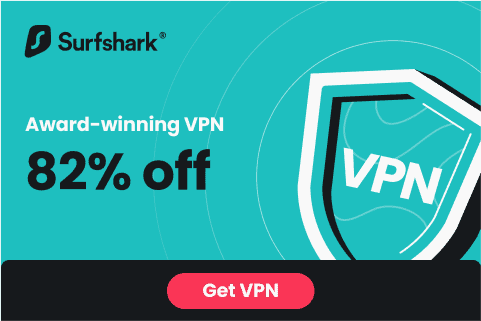
Leave a Reply